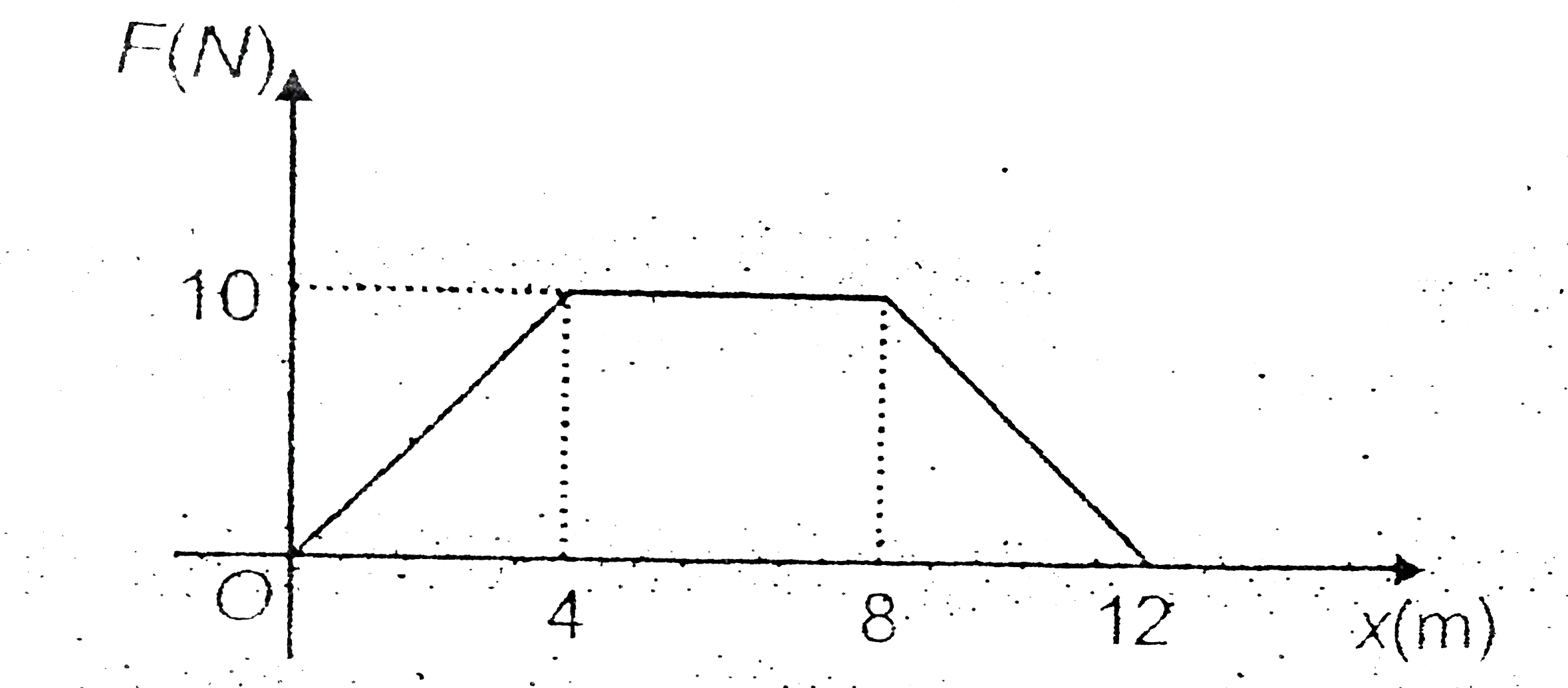A body of mass 0.5 kg travels in a straight line with velocity v=5x3/2. The work done by the net force during its displacement from x=0 to x=2 m is
50J
45J
25J
none of these
The correct Answer is:A
To solve the problem, we will use the work-energy theorem, which states that the work done by the net force on an object is equal to the change in its kinetic energy.
1. Identify Given Values:
- Mass of the body, m=0.5kg
- Velocity function, v=5x3/2
- Displacement from x=0 to x=2m
2. Calculate Initial Velocity (vi):
- At x=0:
vi=5(0)3/2=0m/s
3. Calculate Initial Kinetic Energy (KEi):
- Using the formula for kinetic energy, KE=12mv2:
KEi=12×0.5×(0)2=0J
4. Calculate Final Velocity (vf):
- At x=2:
vf=5(2)3/2=5×2√2=5×2×1.414≈14.14m/s
5. Calculate Final Kinetic Energy (KEf):
- Using the final velocity:
KEf=12×0.5×(14.14)2
- First, calculate (14.14)2:
(14.14)2≈200
- Now calculate KEf:
KEf=12×0.5×200=0.25×200=50J
6. Calculate Change in Kinetic Energy (ΔKE):
- The change in kinetic energy is given by:
ΔKE=KEf−KEi=50J−0J=50J
7. Determine Work Done (W):
- According to the work-energy theorem:
W=ΔKE=50J
Final Answer:
The work done by the net force during the displacement from x=0 to x=2m is 50J.
---
- Mass of the body, m=0.5kg
- Velocity function, v=5x3/2
- Displacement from x=0 to x=2m
- At x=0:
vi=5(0)3/2=0m/s
- Using the formula for kinetic energy, KE=12mv2:
KEi=12×0.5×(0)2=0J
- At x=2:
vf=5(2)3/2=5×2√2=5×2×1.414≈14.14m/s
- Using the final velocity:
KEf=12×0.5×(14.14)2
- First, calculate (14.14)2:
(14.14)2≈200
- Now calculate KEf:
KEf=12×0.5×200=0.25×200=50J
- The change in kinetic energy is given by:
ΔKE=KEf−KEi=50J−0J=50J
- According to the work-energy theorem:
W=ΔKE=50J
The work done by the net force during the displacement from x=0 to x=2m is 50J.
Topper's Solved these Questions
Similar Questions
A particle of mass 0.5kg travels in a straight line with a velocity v=(5x5/2)m/s. How much work is done by the net force during the displacement from x=0 to x=2m ?
View SolutionA particle of mass 0.5kg travels in a straight line with velocity v=ax3/2 where a=5m−1/2s−1. What is the work done by the net force during its displacement from x=0 to x=2m?
View Solution
Knowledge Check
- Question 1 - Select One
A body of mass 0.5kg travels in a straight line with velocity v=ax3/2 where a=5m/s2. The work done by the net force during its displacement from x=0 to x=2m is
A1.5JB50 JC10 JD100 J - Question 2 - Select One
A body of mass 0.5 kg travels in a straight line with velocity v=kx3/2 where k=5m−1/2s−1. The work done by the net force during its displacement from x=0 to x=2 m is
A1.5 JB50 JC10 JD100 J - Question 3 - Select One
A body of mass 0.5 kg travels in a straight line with velocity v=kx3/2 where k=5m−1/2s−1. The work done by the net force during its displacement from x=0 to x=2 m is
A15 JB50 JC10 J4%D100 J
A particle of mass 0.5 kg is subjected to a force which varies with distance as shown in figure

1. The work done by the force during the displacement from x=0 to x=4andx=4 to x=12are respectively
(1)20J,40J(2)40J,40J(3)20J,60J(4)40J,80J
2. The increaase in kinetic energy of the particle during its displac ement from x=0 to x=12 m is
(1)20J(2)40J(3)80J(4)120J
3. If the speed of the particle at x=0 is 4 m/s, its speed st x=8 m is
(1)8m/s(2)16m/s(3)32m/s(4)4m/sView SolutionA body of mass 0.5 kg travels in a straight line with velocity v=kx3/2 where k=5m−1/2s−1 What is the work done by the net force during its displacement from x = 0 to x = 2 m?
View SolutionA body of mass m travels in a straight line with a velocity v=kx3/2 where k is a constant. The work done in displacing the body from x=0 to x is proportional to:
View SolutionA particle of mass 2kg travels along a straight line with velocity v=a√x, where a is a constant. The work done by net force during the displacement of particle from x=0 to x=4m is
View SolutionA force F = (2+ x)N acts on a particle in the x-direction. The work done by this force during a displacement from x = 1.0 m to x = 2.0 m is
View Solution

